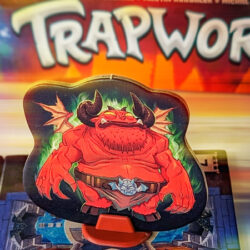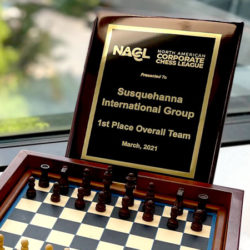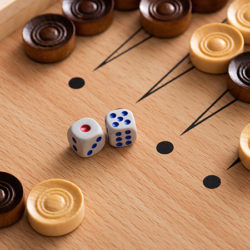
We talk a lot on this site about how various games are related to trading. Poker is our favorite example, but we’ve also mentioned Agricola, Magic: The Gathering, fantasy drafting, and even video games. One may notice, however, that we’ve never mentioned a board game that involves trading. Why is that?
The reason is because most trading games share little in common with financial trading. Take Monopoly, for example; Monopoly has earned the reputation of being a classic, and trading is featured via the exchange of properties and money. Unfortunately, very little strategy is involved in Monopoly. Gameplay is dominated by the roll-and-move mechanic, and most of your decisions are of the form “Do you want to buy this property?” (Hint: the answer to that question is usually “yes.” The optimal Monopoly strategy is to own as many things as you can without going bankrupt.)

The trading component in Monopoly is perhaps the only chance to make interesting decisions in the game. But are they that interesting? Most players want to obtain monopolies, and most players don’t want to give their opponents a monopoly. This yields to everyone trying to bid for the things they want with items their opponents don’t care for. Trading becomes rare, and when a trade does happen, chances are it’s because a player is filibustering and their opponent just wants to move the game along. Does that sound like an active financial market to you?
Let’s try a different game: Settlers of Catan, or “Catan” for short. This is a game where players build settlements connected by roads in order to earn victory points. Each time you want to build something, it costs some combination of wood, brick, sheep, wheat, and ore. These materials make up the resource cards that become the game’s currency. Resources are collected based on the location of your settlements, but they can also be — you guessed it — traded.

Trading plays a larger component in Catan than in Monopoly, and players face a larger decision tree as well. More decisions mean more freedom of choice, and it provides a richer puzzle on how to optimize your play. So did we find our trading model? No, I would argue that we have not. Trading is active in Catan, but it’s easy to find where the best trades are. On top of that, the game tends to play itself out. At any given point, the number of good moves in Catan that a player can make is tiny. Tiny enough for gameplay to feel deterministic. Trading at SIG, on the other hand, offers a massive decision space, and sometimes the best trades are hard to find.
Before going forward, I want to pause and say that I respect these games. Their popularity is impressive, and both have successfully created thousands of happy memories for players. Some people will say that these games offer strategic depth. I am not one of those people, but I recognize that there are great gamers on both sides of the fence here. No matter what side you take, I think you’ll find this next game to be the favorite.
One major limitation that prevents Monopoly and Catan from modeling financial trading is their turn-based design. For example, if it’s Carl’s turn, Carl can trade with Alice, Carl can trade with Bob, but Alice cannot trade with Bob. Carl can take as much time as he pleases coming up with trade structures while Alice and Bob wait for their turn to begin. In finance, however, everyone trades simultaneously, creating a fast-paced and dynamic environment. Are there any board games that simulate that experience?
Enter Chinatown: the board game gem that features trading in one of its purest forms. In Chinatown, players are Chinese immigrants trying to build their new careers in New York City. The object of the game is to earn the most money, and money is earned by laying tiles of the same type on adjacent properties. Everyone starts with a random assortment of tiles and properties, and none of them match up to what people want. Once everyone has their starting materials, someone yells, “Go!” and the markets are open.

Chinatown has no turns, and everything is up for grabs. People start to talk fast, think faster, and scramble to get the best deals from Alice and Bob before they make their trades elsewhere. The free form of Chinatown allows for plenty of different trading techniques. Do you conduct a triangle trade, or do you do the trades as separate pieces in hopes of some arbitrage? If you have a valuable tile that multiple players desperately want, do you conduct an auction or do you give a particular player an immediate offer? Your strategy will depend on your board position, the initial allocation of resources, the trading styles of your counterparties, and your long-term game plan. In other words, the best move in Chinatown will be situation-dependent, just like actual trading.
There is still a significant gap between Chinatown and financial trading, but it comes closer than the vast majority of other board games. If you want to play a game that replicates the information flow and quick decisions that SIG traders face every day (or if you simply want to play a game that is deeper than Monopoly and Catan), give Chinatown a try. I recommend playing this game with a full set of five players. Once you and your friends get the hang of the game, put a timer on each round (7 minutes per round seemed to be the sweet spot in my gaming circles). The timer will keep things interesting by adding extra pressure. But be warned: you might get hooked on this form of trading in games, and the only trading game I’ve found that’s better than Chinatown is what we do here at SIG.




Subscribe Now
Get each new post sent straight to your inbox
We appreciate you taking the time to read our blog and share your feedback. Please be respectful and keep your comments as useful and relevant as possible. We reserve the right to remove comments that contain harassment, offensive language, or are promotional in nature.
Comments are closed.